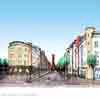Shrub Place Housing, Edinburgh, Wimpey Homes, Developer, Architect
Shrub Place Edinburgh : Alternative Proposal
Shrub Place : Public Enquiry, Edinburgh, Scotland
15 Mar 2004
Shrub Place Development
Shrub Place
An indicative sketch of an alternative Shrub Place scheme drawn up by David Jamieson (Zone Architects House).
David Jamieson’s brief was restricted (by Shrub Place campaigner Mr Tobermann) to an illustration of a traditional legible street coming off Leith Walk, in contrast to Wimpey’s inward-looking proposals and to demonstrate successful integration of the neighbouring site owned by the Masonic Social Club.
Rather than spending effort on detailed architectural design, this was an urban design exercise which – for the sake of comparability – accepted Wimpey’s assumptions about the site and its context (eg number of units needed and density achievable). Prompted by us, these assumptions were tested at two planning committee meetings (and found wanting) and the recent public inquiry.
Wimpey (the developers) subsequently modified their proposal by replacing their original 2-storey pend to Leith Walk with a street opening, but still not achieving a successful layout within the site (compared to our simple proposal). They never discussed our alternative proposal with us.
Mr Tobermann, Shrub Place Campaign leader: information Mar 29 2004
Shrub Place Campaign PR Mar 04
The Shrub Place Public Inquiry concluded today, 25 March with closing submissions from Mr Tobermann on behalf of Third Parties, Mr Steele QC for Edinburgh Council and Mr Martin QC for Wimpey.
Mr Tobermann’s submission argued that the appellant, Wimpey, failed primarily on design grounds: while there clearly was a design, it was not good enough when measured against the six qualities of good design highlighted in the Scottish Executive’s key policy document Designing Places:
– Identity
– Safe and pleasant spaces
– Ease of movement
– Sense of welcome
– Adaptability
– Good use of resources
This was not a matter of subjective value judgement, but evidenced by the poor design statements submitted by the appellant. These amounted to a mere two pages without illustrations and failed to provide a design narrative (as outlined in government guidance PAN 68):
a) how the six design qualities prescribed by Designing Places will be achieved
b) how the appellant went about the design process
c) why certain – possibly less attractive – design decisions were taken
d) how certain design shortcomings of both appeal schemes could be fixed by post-hoc conditions without compromising the putative design integrity of either scheme.
Describing the appellant’s design as “unsound”, Mr Tobermann concluded by asking the Reporters to dismiss all appeals and to make a number of constructive recommendations to guide subsequent fresh applications for Shrub Place.
Mr Steele QC for City of Edinburgh Council relied in his submission on existing policies and guidance and demonstrated where the appellant had deviated without good reason. A key part of his submission covered poor day and sunlighting provision, as well as the large number of single aspect flats.
He argued forcefully for the Council’s Affordable Housing Policy to be applied, and cited legal precedent that an incorrectly described planning application (as in the case of the listed building consent sought with the second appeal scheme) must be refused by a Reporter. He concluded by inviting the Reporters to refuse the appeals before them.
Mr Martin QC for Wimpey made a forceful case against the Council’s handling of Wimpey’s planning applications. His arguments for granting planning permission were far less convincing and suffered from too high a dose of vitriol.
He concluded by asking the Reporters to award costs against the Council, whose behaviour he described as “unreasonable” to an unprecedented degree. Mr Steele QC, replying to the cost submission, refuted the accusations of unreasonable behaviour. He described some of the allegations, especially against him personally, as “breathtaking”.
The Reporters closed the Inquiry by thanking all participants. Their report and decision is not expected for some weeks or even months. Mr Tobermann, speaking after the Inquiry had closed, said: “While we regret that we were unable to refute the incorrect allegations against some of our witnesses made in Mr Martin’s submission – the appellant has the last word – we remain quietly confident that our “design” case will stand up to the Reporters’ scrutiny.
Judging by the lacklustre arguments revolving around planning matters in Mr Martin’s closing submission, compared to his case against the Council’s alleged behaviour and his consequent claim for expenses which he presented with some gusto, Wimpey’s case looks far less promising.”
Shrub Place Campaign PR Mar 25, 2004
Shrub Place is a landmark site on Leith Walk – halfway between the Castle and the Sea, between Edinburgh and Leith, between the Scottish Parliament and the Scottish Executive”
Shrub Place Campaign PR Mar 23, 2004
The Shrub Place Public Inquiry concludes on 25 March with closing submissions, following two weeks of witness statements and intense cross-examination.
The Inquiry will sit from 2.30pm at the McDonald Road Library’s Nelson Hall to hear closing submissions from Mr Tobermann on behalf of Third Parties, Mr Steele QC for Edinburgh Council and Mr Martin QC for Wimpey.
Harald Tobermann, chairman of Pilrig Residents Association, said: “We are grateful to all local residents and supporters who managed to attend the Inquiry whenever they could. Thursday’s closing submissions – open to the public! – will neatly summarise the case made by all parties. We are quietly confident that ours and the Council’s arguments are better and will win in the end.”
Key points that emerged during the Inquiry:
a. Wimpey failed to provide a cross section of the crucial Leith Walk elevation of both their appeal schemes. Surveys conducted during the Inquiry established that the appearance of existing buildings on Croall Place was not accurately represented in Wimpey’s drawings and that the falling ground of Leith Walk south to north with its attractive sandstone facades were insufficiently respected
b. the future of the Masonic Social Club at Shrub Place Lane is under threat by Wimpey’s proposals (including possible unreasonable constraints on residential
development opportunities available to the Club)
c. a key document, the Design Statement, meant to provide vital background and design reasoning, was produced by Wimpey only during the Inquiry and falls short of Government guidance in substance and volume
d. Wimpey is likely to concede that Edinburgh’s oldest colonies, originally known as Pilrig Model Buildings, will keep their unique intimate character, but may still be threatened by overshadowing by Wimpey’s proposed tall buildings south of the colonies
e. fine vistas to Arthur’s Seat and Calton Hill from the existing tower block (Inchkeith Court) will be disrupted by Wimpey’s proposed second tower to the south of Inchkeith Court
Shrub Place Development : further information
LRT Bus Depot, Leith Walk
Wimpey Homes’ six-storey 314-flat scheme for Shrub Place, Jenkins & Marr Architects, set to get go ahead next week.
The proposed transformation of a derelict bus depot into luxury flats looks set to get the go-ahead despite a flood of protests from neighbours. Alan Henderson describes the plans as a good representative of contemporary design. 9 Aug 2002
Shrub Place was placed on the market for a second time, in Sep 2004.
Comments / photos for the Shrub Place Development page welcome

